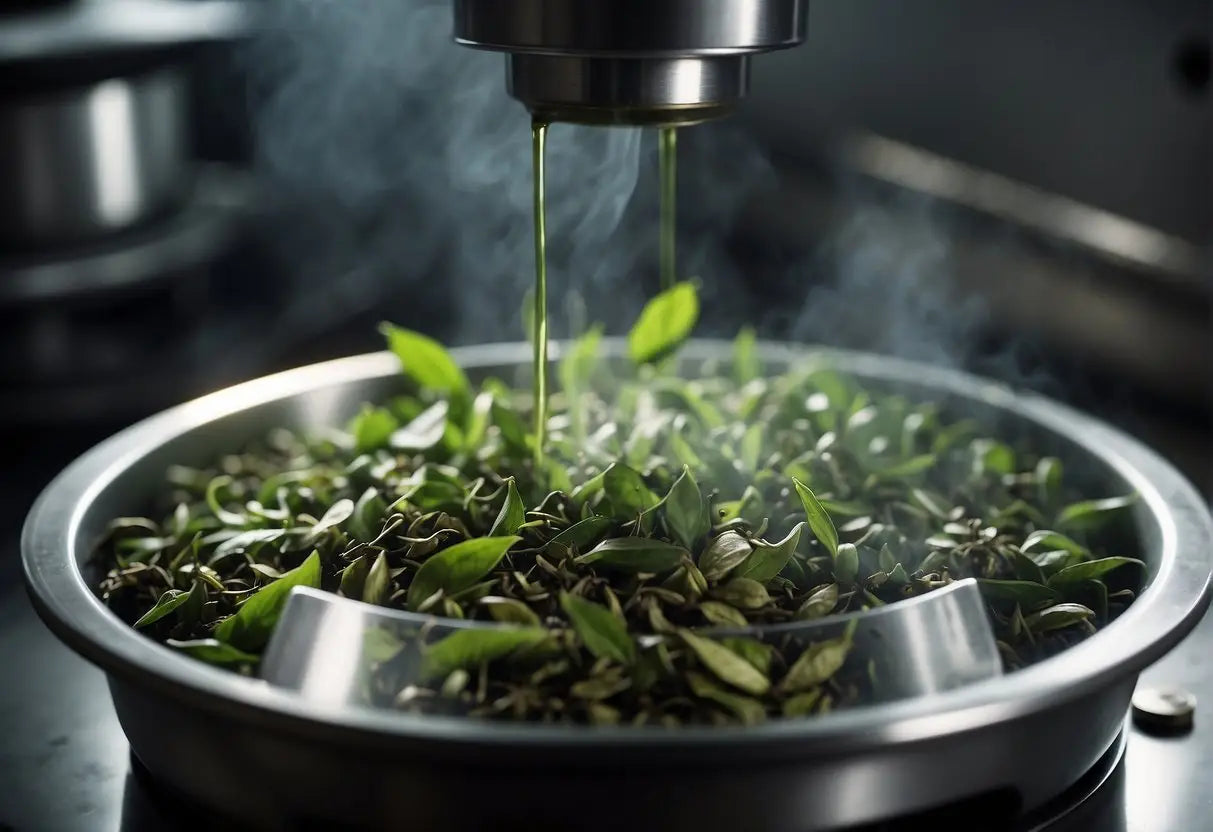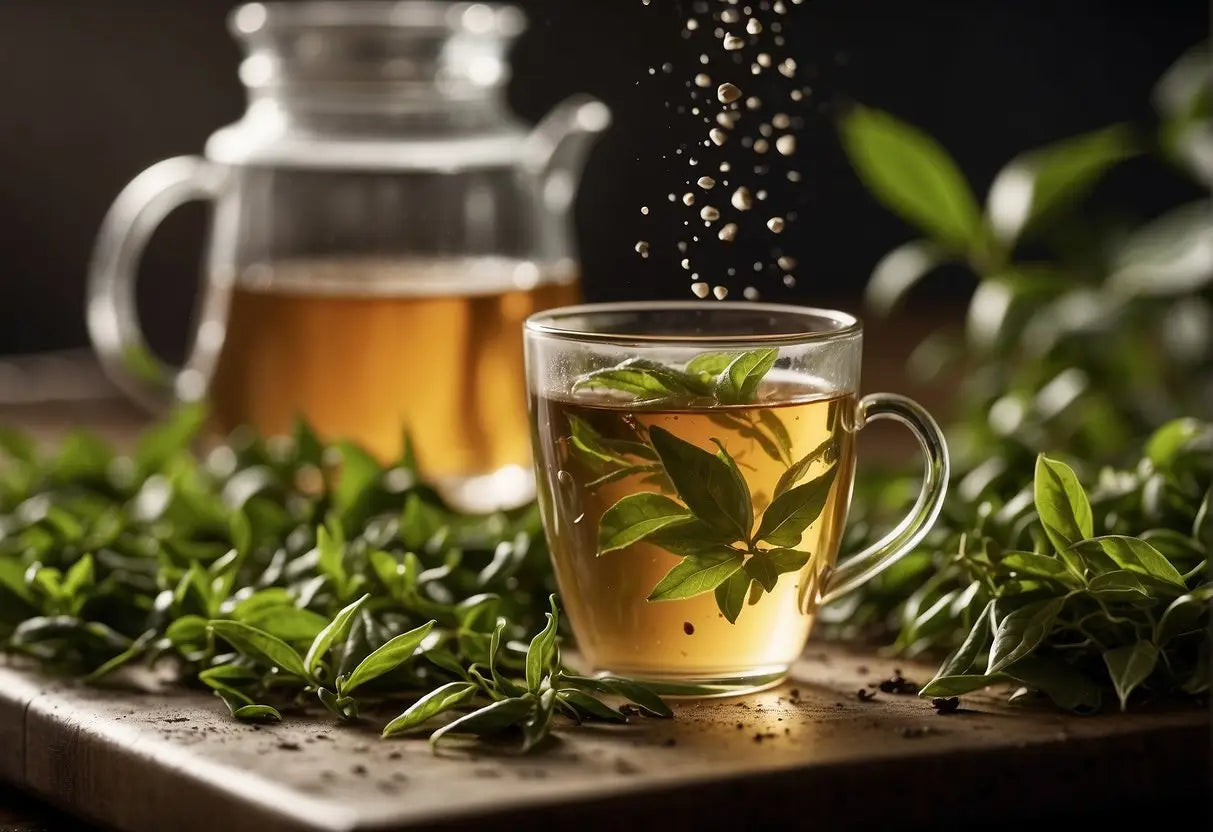How is Tea Decaffeinated
Decaffeination is the process of removing most, but not all, of the caffeine from tea leaves. It's crucial to understand that decaffeinated tea is not caffeine-free, but it contains significantly lower amounts of caffeine compared to regular tea.
Methods of Decaffeination
-
Chemical Solvent Process: Utilizes chemical solvents like ethyl acetate or dichloromethane to extract caffeine. Your tea's flavor and essence are largely retained during this process.
-
CO2 (Carbon Dioxide) Process: Employs supercritical carbon dioxide, a dense fluid state of CO2, for caffeine extraction. You'll find that this method does not leave any chemical residues and is gentle on the tea's flavor.
-
Water Process: Also known as the Swiss Water Process, this method uses hot water and charcoal filtering to remove caffeine. Your tea tastes clean as the process is entirely chemical-free.
Efficiency of Methods
| Method | Caffeine Removal | Flavor Preservation | Chemical Use |
|---|---|---|---|
| Chemical Solvent | High | Moderate | Yes |
| CO2 | High | High | No |
| Water | Moderate | High | No |
Considerations
When selecting decaffeinated tea, consider the decaffeination method used as it impacts the final taste and chemical composition. Your personal preference for natural methods versus efficiency may influence your choice. Rest assured, all methods used commercially need to comply with stringent health and safety regulations to ensure the final product is safe for consumption.
Methods of Decaffeination

When you're choosing decaffeinated tea, it's important to understand the methods used for reducing the caffeine content. The process can influence flavor and health benefits.
Solvent-Based Method
The solvent-based method uses chemical solvents, like methylene chloride or ethyl acetate, to remove caffeine from tea leaves. Your tea leaves are first soaked in water and then introduced to the solvent, which selectively binds to caffeine molecules. After the caffeine is dissolved, the solvent is removed, leaving decaffeinated tea leaves behind.
Swiss Water Process
The Swiss Water Process involves no chemicals, ensuring a 99.9% caffeine-free product. Tea leaves are soaked in hot water to dissolve caffeine. Then, the caffeine-laden water is passed through a carbon filter, trapping the caffeine but retaining the tea's flavors. This filtered water is then used to decaffeinate new batches of tea through osmosis, limiting flavor loss.
Carbon Dioxide Process
Lastly, the Carbon Dioxide Process utilizes supercritical CO2, a state where CO2 has both liquid and gas properties, to decaffeinate tea. Under high pressure, CO2 circulates through the tea leaves, attaching itself to the caffeine. Because CO2 is a selective solvent for caffeine, it doesn't remove the beneficial compounds, preserving the tea's authentic taste.
Factors Affecting Decaffeination
When you explore how tea is decaffeinated, several factors influence the effectiveness and quality of the decaffeination process.
Type of Tea: The kind of tea leaf—black, green, oolong, or white—affects the decaffeination process due to varying levels of natural caffeine and different reactions to decaffeination methods.
Lao Ban Zhang
Decaffeination Method: The technique used can impact the tea’s flavor and caffeine residue. Common methods include:
- Carbon Dioxide (CO2) Process: Preserves flavor but is more expensive.
- Ethyl Acetate Method: Often labeled as "naturally decaffeinated," it can leave a slight chemical taste.
- Methylene Chloride Method: Effective but may raise health concerns and is not permitted in some countries.
- Water Process (Swiss Water Process): Maintains a cleaner flavor, though may result in a milder tea.
Temperature and Time: The efficiency of decaffeination is influenced by the temperature and duration of treatment. Higher temperatures and longer processing times can extract more caffeine but may affect the tea's subtleties.
Leaf Size: Smaller leaf particles have more surface area and decaffeinate more quickly than larger leaves.
In your selection of decaffeinated tea, consider these factors to ensure you receive a product that suits your taste preferences and aligns with your health considerations.
Health and Safety Considerations

When considering how tea is decaffeinated, it is imperative to address the health and safety implications for you as a consumer. There are key points you should understand:
- Chemical Solvents: Most methods involve chemical solvents such as ethyl acetate or methylene chloride. While these solvents are used within regulatory safety limits, you may prefer teas decaffeinated using the CO2 process or water method to avoid these chemicals.
- Residual Solvents: Although solvents used are within safe consumption levels, minimal traces can remain in the tea. Always check labels for information on the decaffeination process used if you are concerned about solvent residuals.
- Nutritional Changes: The decaffeination process can slightly alter the flavor and reduce the levels of beneficial antioxidants in the tea. However, the changes are typically minimal, keeping the tea a healthy option.
Precautions You Can Take
- Opt for brands that use the CO2 or water decaffeination processes if you wish to avoid chemical solvents altogether.
- Look for organic certifications to ensure that the tea has been processed according to specific health and safety standards.
Remember, while decaffeinated tea offers a lower caffeine alternative to regular tea, it's important you choose a decaffeination method that aligns with your health and safety preferences.
Environmental Impacts

When considering the decaffeination of tea, it's essential to understand the environmental consequences. The process mainly employs three methods: solvent-based, CO2, and water processing.
-
Solvent-based Method: The use of chemical solvents like methylene chloride or ethyl acetate can lead to environmental concerns. If these chemicals are not handled properly, they can contaminate water and soil, and pose risks to local flora and fauna.
- Proper disposal: Chemicals must be disposed of according to strict regulations to mitigate harmful effects.
-
CO2 Method: This method is considered relatively eco-friendly. However, the energy consumption required for creating high pressures can contribute to carbon emissions.
- Sustainable energy: Employing renewable energy sources can reduce this impact.
-
Water Processing: Often touted as the most environmentally benign method, water processing (usually known as the Swiss Water Process) uses only water to extract caffeine. While it avoids chemical use, it requires a significant amount of water.
- Water conservation: Efficient water management systems are crucial to minimize waste.
Each method comes with its own set of challenges for the environment, and your awareness can drive demand for more sustainable practices. By supporting brands that invest in eco-friendly methods or certifications, you encourage better industry standards. Remember, your consumer decisions have the power to shape environmental outcomes in the tea industry.
Decaffeinated Tea vs Regular Tea

When you choose between decaffeinated tea and regular tea, you are comparing two varieties of the same leaf that have undergone different processing methods. Decaffeinated tea has had the majority of its caffeine removed, making it a favored option for those seeking to reduce caffeine intake.
Caffeine Content:
- Regular Tea: typically contains about 20 to 70 milligrams of caffeine per 8 oz cup.
- Decaffeinated Tea: generally retains 1 to 5 milligrams of caffeine per 8 oz cup.
Methods of Decaffeination: Decaffeinated teas undergo processes such as:
- The Carbon Dioxide (CO2) Method
- The Ethyl Acetate Method
- The Methylene Chloride Method
- The Water Processing Method
These methods aim to maintain the flavor profile of the tea while removing caffeine content.
Flavor and Aroma: While decaffeinated tea attempts to preserve the original flavor, some connoisseurs argue that the decaffeination process slightly alters the tea's taste. Yet, advances in decaffeination technology have reduced these flavor variations.
Health Considerations:
- If you're sensitive to caffeine or drinking tea late in the day, it's wise to opt for decaffeinated tea.
- Regular tea can be beneficial if you are looking for a moderate boost in focus and energy.
When considering decaffeinated vs regular tea, your choice depends on personal health considerations and taste preferences. Remember that the decaffeination process reduces caffeine content but may slightly affect the natural character of the tea.
Market and Consumer Trends

In the decaffeinated tea market, you'll notice a growing preference for natural decaffeination processes. The consumer focus on health and wellness drives demand for methods like the Swiss Water Process or CO2 process, which don't involve chemicals.
Key Trends:
- Health Consciousness: Increased awareness surrounding the negative impacts of artificial chemicals has bolstered your preference for naturally decaffeinated teas.
- Variety and Quality: You seek a wider variety of high-quality decaf teas, with preferences shifting towards premium, organic options.
- Transparency: You highly value transparency in production methods and sourcing.
Decaffeination Methods Preferred:
- CO2 Process
- Swiss Water Process
Table of Market Preferences:
| Consumer Preferences | Percentage (%) |
|---|---|
| Natural Processes | 65% |
| Chemical-Free | 55% |
| Organic Certification | 50% |
As a consumer, you are becoming more knowledgeable, which drives brands to innovate and provide a broader range of decaffeinated products. Ethical sourcing and fair trade have also become significant factors in your purchasing decisions. The market has seen a growth in specialty decaf teas, catering to your refined palates and diverse preferences.
Frequently Asked Questions
This section covers commonly asked questions about the decaffeination of tea, detailing commercial methods, home practices, health implications, natural production, specific brands, and differing techniques.
What methods are used to decaffeinate tea commercially?
Commercially, tea is decaffeinated using methods such as carbon dioxide (CO2) processing, ethyl acetate or methylene chloride solvent extraction, and the water process. Each technique has varying effects on flavor and health benefits.
Can decaffeination be done at home, and if so, how?
Yes, you can decaffeinate tea at home by briefly steeping tea leaves in hot water for 30 to 60 seconds then discarding this water. The subsequent infusions will have less caffeine, but this method also reduces flavor and beneficial compounds.
What are the health implications of consuming decaffeinated tea?
Decaffeinated tea offers lower caffeine content which can be beneficial for those needing to limit their caffeine intake due to pregnancy, heart conditions, or sleep disturbances. However, some chemical residues from the decaffeination process may remain.
Are there natural ways to produce decaffeinated tea, and what are they?
Naturally decaffeinated tea can be produced by selecting tea plants that naturally contain lower levels of caffeine or by cross-breeding different varieties of tea plants to cultivate ones with reduced caffeine content without using chemicals.
Which brands offer tea that has been decaffeinated using the CO2 process?
Brands such as Harney & Sons, Twinings, and Republic of Tea offer teas decaffeinated via the CO2 process, which maintains better flavor integrity and avoids chemical solvents.
How does the water process for decaffeinating tea differ from other methods?
The water process, often referred to as the Swiss Water Process, involves using water to saturate the tea leaves, extracting caffeine along with other soluble compounds. This mixture is then passed through a carbon filter to remove the caffeine, and the flavorful compounds are reintroduced to the tea. This method avoids synthetic chemicals and is considered more gentle on the tea's natural attributes.
← Older post Newer post →











